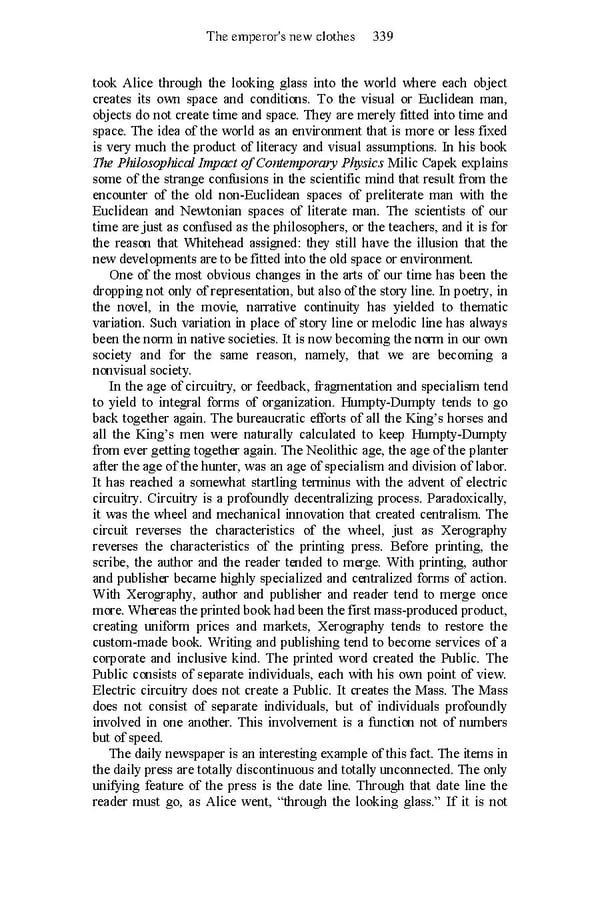The emperor's new clothes 339 took Alice through the looking glass into the world where each object creates its own space and conditions. To the visual or Euclidean man, objects do not create time and space. They are merely fitted into time and space. The idea of the world as an environment that is more or less fixed is very much the product of literacy and visual assumptions. In his book The Philosophical Impact of Contemporary Physics Milic Capek explains some of the strange confusions in the scientific mind that result from the encounter of the old non-Euclidean spaces of preliterate man with the Euclidean and Newtonian spaces of literate man. The scientists of our time are just as confused as the philosophers, or the teachers, and it is for the reason that Whitehead assigned: they still have the illusion that the new developments are to be fitted into the old space or environment. One of the most obvious changes in the arts of our time has been the dropping not only of representation, but also of the story line. In poetry, in the novel, in the movie, narrative continuity has yielded to thematic variation. Such variation in place of story line or melodic line has always been the norm in native societies. It is now becoming the norm in our own society and for the same reason, namely, that we are becoming a nonvisual society. In the age of circuitry, or feedback, fragmentation and specialism tend to yield to integral forms of organization. Humpty-Dumpty tends to go back together again. The bureaucratic efforts of all the King’s horses and all the King’s men were naturally calculated to keep Humpty-Dumpty from ever getting together again. The Neolithic age, the age of the planter after the age of the hunter, was an age of specialism and division of labor. It has reached a somewhat startling terminus with the advent of electric circuitry. Circuitry is a profoundly decentralizing process. Paradoxically, it was the wheel and mechanical innovation that created centralism. The circuit reverses the characteristics of the wheel, just as Xerography reverses the characteristics of the printing press. Before printing, the scribe, the author and the reader tended to merge. With printing, author and publisher became highly specialized and centralized forms of action. With Xerography, author and publisher and reader tend to merge once more. Whereas the printed book had been the first mass-produced product, creating uniform prices and markets, Xerography tends to restore the custom-made book. Writing and publishing tend to become services of a corporate and inclusive kind. The printed word created the Public. The Public consists of separate individuals, each with his own point of view. Electric circuitry does not create a Public. It creates the Mass. The Mass does not consist of separate individuals, but of individuals profoundly involved in one another. This involvement is a function not of numbers but of speed. The daily newspaper is an interesting example of this fact. The items in the daily press are totally discontinuous and totally unconnected. The only unifying feature of the press is the date line. Through that date line the reader must go, as Alice went, “through the looking glass.” If it is not
 Essential McLuhan Page 345 Page 347
Essential McLuhan Page 345 Page 347